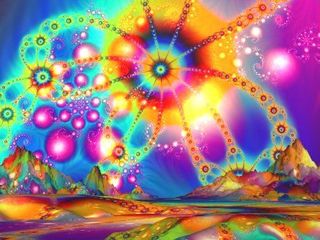Intelligence
Does DMT Model the Near-Death Experience?
Despite parallels, there are profound differences between DMT and NDEs.
Posted October 19, 2018 Reviewed by Matt Huston
The authors of a recent study (Timmermann et al., 2018) argue that what people experience under the influence of DMT provides a model of what people undergo during near-death experiences. Although there are broad similarities between the two, there are also major differences that the authors do not address. DMT experiences and NDEs may overlap because they share certain common features associated with altered states of consciousness. However, claiming that DMT models near-death experiences greatly exaggerates their similarities and overlooks what makes each distinctive.
Speculation vs. evidence about the role of DMT

Dimethyltryptamine (DMT) is a psychedelic drug with striking properties. Although less well-known than other psychedelics such as psilocybin or LSD, DMT has become the focus of a number of wildly speculative theories about its role in human experience. Specifically, Rick Strassman, a psychiatrist who conducted research on DMT, advanced such speculations in his book, The Spirit Molecule. (I discussed some of these in three previous posts, here, here, and here.) Strassman claimed that reports of near-death experiences have a striking resemblance to DMT-induced states. For example, in both types of experiences, people report a sense of “hyper-reality,” i.e. a feeling that the experience is more real than ordinary life, as well as feelings of leaving one’s body behind and entering an unearthly realm, feelings of bliss, and encounters with a spiritual presence of some kind. Strassman speculated that, in times of extreme stress, the pineal gland in the human brain produces large quantities of endogenous DMT that trigger mystical experiences associated with death and dying. Although there is evidence that DMT is produced in the human body, there is no evidence that it is involved in near-death experiences. Regarding endogenous DMT, a review of 69 studies (Barker, McIlhenny, & Strassman, 2012) did provide evidence that DMT can be found in the human body, e.g. it has been found in blood, urine, and cerebrospinal fluid. However, where it is produced and what function it may have remains unknown. Another study found that DMT was present in the pineal gland in rats (Barker, Borjigin, Lomnicka, & Strassman, 2013). It should be noted though, that the amounts of DMT found in these studies were extremely minute. Furthermore, it seems highly unlikely that, even if the pineal gland is capable of producing DMT, it would be able to produce the amount required to trigger a psychedelic experience. One author (Nichols, 2018) estimated that the pineal gland would need to produce about 25 milligrams of DMT in a few minutes for this to occur, yet in the course of a day it normally produces about 30 micrograms of melatonin, which is about one-thousandth of the weight of DMT needed to induce a psychedelic breakthrough. Hence, producing this much DMT seems impossible. Nichols also notes that there is no evidence that endogenous DMT can naturally accumulate in the brain at high enough concentrations to produce psychedelic effects, as it is rapidly metabolized and would be broken down as soon as it was produced. Hence, endogenous DMT is highly unlikely to explain near-death experiences.
Parallels between DMT & near-death experiences
Despite these concerns, the authors of a recent study (Timmermann et al., 2018) examined whether DMT induces “near-death type experiences” that would be comparable in intensity to those who have reported actual, naturally occurring near-death experiences. Although the authors did not necessarily endorse Strassman’s theory, they did not provide a compelling reason to suppose that DMT provides a model of near-death experience beyond noting that there are certain parallels between them. In their study, they recruited 13 volunteers who were given DMT and compared their experiences to those of a sample of people who had undergone a near-death experience, and who were matched to the DMT group on age and gender. At this point, I want to mention that Robin Carhart-Harris, one of the co-authors of this study, has produced a number of studies on the effects of psychedelic drugs that I would describe as “tantalising.” On the one hand, the topics investigated and the findings have been genuinely intriguing, yet on the other hand, they have all involved tiny numbers of participants, which makes it difficult to generalise from the results or take the statistics involved too seriously. This is another one of these studies – a fascinating topic, studied with a tiny sample. And once again, the results were quite interesting, but need to be interpreted very cautiously.
The study involved two testing sessions. In the first, participants were administered a placebo, in the second, DMT. Before these sessions, participants completed a measure of the personality trait absorption, which is the tendency to experience episodes of “complete attention” in which one becomes immersed in one’s ongoing experience. Absorption is known to be associated with a tendency to experience natural altered states of consciousness, and previous research has found that people high in absorption have much more intense responses to psychedelic drugs than those lower in this trait (Studerus, Gamma, Kometer, & Vollenweider, 2012). Participants also completed a measure of “delusional thinking,” that is, belief in and experience of a range of paranormal phenomena (e.g. telepathy, witchcraft, etc.). After each session when the effects had subsided, participants completed the NDE scale, a questionnaire designed to assess aspects of the near-death experience. Those who had undergone an actual near-death experience completed the same measure, and the results were compared. Additionally, participants in the DMT group completed two questionnaires to assess how profoundly they were affected by DMT compared to the placebo: the Ego Dissolution Inventory and the Mystical Experiences Questionnaire.
Correlations between the measures in the DMT group were very strong. The NDE scale had strong positive correlations with both the Ego Dissolution Inventory and the Mystical Experiences Questionnaire in particular, showing that participants’ responses to the NDE scale strongly overlapped with their sense of having a profoundly altered state involving mystical experiences, such as transcendence of time and space, feelings of joy, and ineffability. Additionally, participants’ scores on absorption and paranormal belief were each positively correlated with their NDE scale scores. This result fits with previous research that found that people who have had a near-death experience also tend to be high in absorption and to believe in paranormal phenomena. When the DMT group’s NDE scale scores were compared to those of the comparison group, there were many similarities in intensity, although there were some notable differences. For example, people in both groups were about equally likely to report feelings of peace and joy, feeling separated from their bodies, entering some other, unearthly world, encountering a mystical being or presence, and so on. However, many people in the near-death experience group reported coming to a border or point of no return, while this was much less common in the DMT group. Additionally, the near-death experience group were more likely to report seeing deceased or religious spirits, although this difference was not statistically significant (hardly surprising, given the small sample size, yet the difference was substantial, being half a standard deviation, which is conventionally considered a medium effect size). Additionally, in the DMT group, 10 of the 16 items in the NDE scale were higher under DMT than the placebo. The six items that did not differ between DMT and placebo included several items that seem especially relevant to the experience of coming close to death, e.g. coming to a border or point of no return, seeing deceased or religious spirits, and life review (i.e. reexperiencing scenes from one’s past). (The other three items were “understanding everything,” visions of the future, and ESP.) All six of these items were higher in the near-death experience group, and apart from ESP, substantially so (i.e., half a standard deviation or more).
OK, but what about the differences?
The authors concluded that their results showed that there was “an intriguingly strong overlap between specific and broad features of these states” (i.e. DMT and near-death experiences). They go on to suggest that “the putatively strong overlap between the phenomenology and neurobiology of DMT (and other psychedelic) experiences and ‘actual’ near-death experiences” should be investigated further. I agree that the findings are intriguing, and I acknowledge that they describe the overlap between DMT and near-death experiences as “putative” (i.e. something that is supposed but which may not be true). However, I also think that they overstate some of the similarities between the two kinds of experiences based on the nature of the measures used, and largely ignore some striking differences between them. Although accounts of near-death experiences are heterogeneous, many people have reported phenomena like moving through a dark tunnel and then suddenly encountering a brilliant light (French, 2005). However, I have yet to read an account of a DMT experience with these features. Furthermore, one of the most salient features of the DMT experience involves intense visual imagery. For example, in one study, all volunteers reported “an intensely colored, rapidly moving display of visual images” that began within seconds of DMT being administered (Strassman, Qualls, Uhlenhuth, & Kellner, 1994). These images included concrete representational forms, such as animals, human and alien figures, and landscapes, as well as abstract designs, such as kaleidoscopic geometric patterns. Colors were brighter, more intense, and more richly saturated than in waking life or dreams. One participant stated that, “It was like the blue of a desert sky, but on another planet. The colors were 10 to 100 times more saturated.” On the other hand, vivid imagery and colors are not prominent at all in accounts of near-death experiences. In fact, when the NDE scale, which Timmermann et al. (2018) used in their study, was first developed, the author (Greyson, 1983) started with a list of 80 items concerning phenomena that have been reported in near-death experiences and then selected the 40 most commonly reported items to include in the scale. (These 40 items were later reduced to 16 when the final scale was developed.) Interestingly, the original pool of 80 items included “colors seeming unusually vivid,” yet this experience was not common enough to be included in the top 40. Furthermore, there were no items resembling a “rapidly moving display of visual images,” geometric patterns, or anything similar. This suggests that, unlike when people take DMT, near-death experiences are not commonly dominated by intense visual displays or unusually saturated colours.
Furthermore, although people under the influence of DMT and people who have had near-death experiences report conventional spiritual phenomena, such as encountering a mystical being or presence, people on DMT have often reported experiences that seem quite unlike anything reported in the NDE literature. In Strassman’s study, many people reported sensing that an “other intelligence” was present that was “supra-intelligent” but also “emotionally detached” (Strassman et al., 1994). Additionally, many reported seeing non-human entities that seemed alien, such as giant insects, talking cacti, and other creatures, or feeling that they were in an alien place. These encounters were generally unexpected, and the volunteers found them difficult to explain. On the other hand, people who have undergone near-death experiences generally report encounters that fit in with their pre-existing religious beliefs. For example, Christians often report meeting Jesus, whereas Hindus have reported meeting Hindu deities, such as the messengers of Yamraj (god of death) coming to collect them (French, 2005). Additionally, as I noted earlier, near-death experiences commonly involve meeting deceased relatives, something that many people believe will happen to them when they die, yet this does not seem to be very common on DMT.
Timmermann et al. (2018) argued that specific differences between DMT and near-death experiences are likely to be a function of contextual factors, such as the person’s expectations. While I would agree that this could explain some of the differences, I don’t think this is sufficient to explain them all. For example, it makes sense that if a person believes they are dying that their experiences would be shaped by their prior beliefs about what happens when you die. Hence, this might explain why some people report meeting departed loved ones or reaching a border that marks the boundary between life and death: many people believe that dying involves crossing over from this life to the next and that they will be reunited with their families. On the other hand, this would not go any way near explaining why people on DMT experience rapidly changing and intensely colourful images or unexpected encounters with alien entities, while people having near-death experiences typically do not.
Possible mechanisms in near-death experience
Although Timmermann et al. argue that DMT represents a “model” of near-death experience, another perspective is that they both trigger profoundly altered states of consciousness through different mechanisms. Other research has found that when the brain is temporarily deprived of oxygen (cerebral anoxia), altered states of consciousness can result that also resemble near-death experiences in many respects. Fighter pilots performing maneuvers that expose them to high g-forces often experience temporary cerebral anoxia and have reported experiencing phenomena such as tunnel vision, bright lights, out-of-body experiences, seeing themselves as if from outside, vivid dreamlets of beautiful places, feelings of euphoria and dissociation, sensing the presence of friends and family, and much more (French, 2005). Hence, one theory suggests that near-death experiences in people undergoing cardiac arrest may be induced by cerebral anoxia. This is not say that this explains all near-death experiences, as these might have many different causes depending on the circumstances. However, it suggests that there might be multiple factors that induce people to undergo mystical experiences that appear to be common to both near-death and psychedelic drug experiences.
Additionally, similarities between DMT-induced and near-death experiences might reflect similarities in personality traits, which in turn might be related to neurological factors underlying such traits. Timmermann et al. found that participants who were higher in absorption and paranormal beliefs had higher NDE scale scores, indicating they had more profound experiences on DMT. This accords with previous findings that people high in absorption tend to have more profound experiences on other psychedelic drugs (Studerus et al., 2012), and that people who have had near-death experiences also tend to be higher in absorption and paranormal beliefs. Individual differences in absorption are associated with particular neurotransmitter receptors in the serotonin system that are acted upon by psychedelic drugs (Ott, Reuter, Hennig, & Vaitl, 2005) (which I touched upon in a previous post). People high in trait absorption are prone to experience altered states of consciousness even without drugs and are also more inclined to paranormal and “spiritual” beliefs and experiences (Thalbourne, 2010), which might help explain why they are more likely to have near-death experiences than other people. Timmermann et al. consider that serotonergic functioning may contribute to both psychedelic and near-death experiences, which I think is quite plausible. However, if this is correct, it still does not mean that DMT provides a particularly good model for near-death experiences. DMT and near-death experiences may well share certain underlying neurological and psychological characteristics, but so do many other phenomena associated with altered states of consciousness.
Conclusions: let's not jump to them
Timmermann et al. conclude by arguing that further research is needed into the overlap between DMT and near-death experiences, considering that “scientifically problematic yet influential claims” have been made about the latter (such as Eben Alexander’s claim that they constitute “proof of Heaven”). I agree that further research is warranted, but I think it is worth pointing out that “scientifically problematic yet influential claims” have also been made about DMT, especially by Rick Strassman in several of his books. Overstating the similarities between DMT and near-death experiences could inadvertently lend credibility to such claims. The striking differences between DMT and near-death experiences are intriguing in themselves, and worthy of further study.
© Scott McGreal. Please do not reproduce without permission. Brief excerpts may be quoted as long as a link to the original article is provided.
References
Barker, S. A., Borjigin, J., Lomnicka, I., & Strassman, R. (2013). LC/MS/MS analysis of the endogenous dimethyltryptamine hallucinogens, their precursors, and major metabolites in rat pineal gland microdialysate. Biomedical Chromatography, 27(12), 1690–1700. https://doi.org/10.1002/bmc.2981
Barker, S. A., McIlhenny, E. H., & Strassman, R. (2012). A critical review of reports of endogenous psychedelic N, N-dimethyltryptamines in humans: 1955–2010. Drug Testing and Analysis, 4(7–8), 617–635. https://doi.org/10.1002/dta.422
French, C. C. (2005). Near-death experiences in cardiac arrest survivors. In S. Laureys (Ed.), Progress in Brain Research (Vol. 150, pp. 351–367). Elsevier. https://doi.org/10.1016/S0079-6123(05)50025-6
Greyson, B. (1983). The Near-Death Experience Scale: Construction, Reliability, and Validity. The Journal of Nervous and Mental Disease, 171(6), 369–375. https://doi.org/10.1016/S0163-8343(03) 00042-2
Nichols, D. E. (2018). N,N-dimethyltryptamine and the pineal gland: Separating fact from myth. Journal of Psychopharmacology, 32(1), 30–36. https://doi.org/10.1177/0269881117736919
Ott, U., Reuter, M., Hennig, J., & Vaitl, D. (2005). Evidence for a common biological basis of the absorption trait, hallucinogen effects, and positive symptoms: Epistasis between 5-HT2a and COMT polymorphisms. American Journal of Medical Genetics Part B: Neuropsychiatric Genetics, 137B(1), 29–32. https://doi.org/10.1002/ajmg.b.30197
Strassman, R. J., Qualls, C. R., Uhlenhuth, E. H., & Kellner, R. (1994). Dose-Response Study of N,N-Dimethyltryptamine in Humans: II. Subjective Effects and Preliminary Results of a New Rating Scale. Archives of General Psychiatry, 51(2), 98–108. https://doi.org/10.1001/archpsyc.1994.03950020022002
Studerus, E., Gamma, A., Kometer, M., & Vollenweider, F. X. (2012). Prediction of Psilocybin Response in Healthy Volunteers. PLoS ONE, 7(2), e30800. https://doi.org/10.1371/journal.pone.0030800
Thalbourne, M. A. (2010). Transliminality: A Fundamental Mechanism in Psychology and Parapsychology. Australian Journal of Parapsychology, 10(1), 70.
Timmermann, C., Roseman, L., Williams, L., Erritzoe, D., Martial, C., Cassol, H., … Carhart-Harris, R. (2018). DMT Models the Near-Death Experience. Frontiers in Psychology, 9. https://doi.org/10.3389/fpsyg.2018.01424




